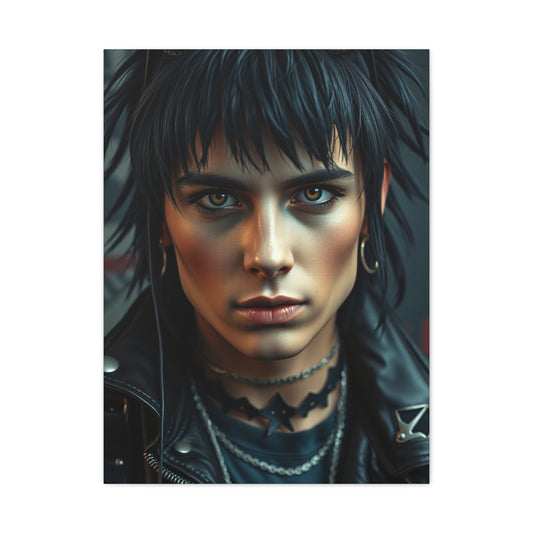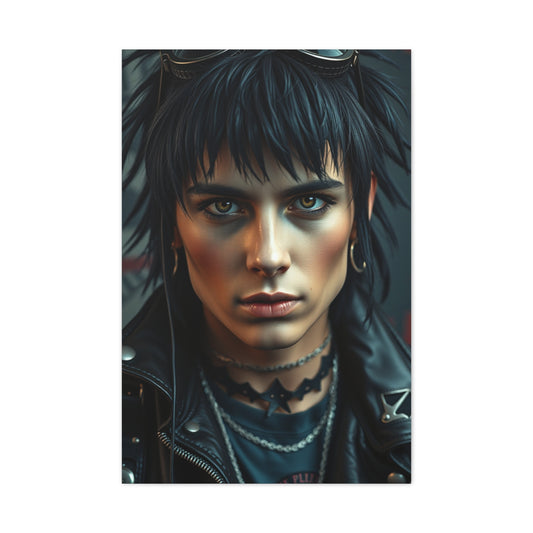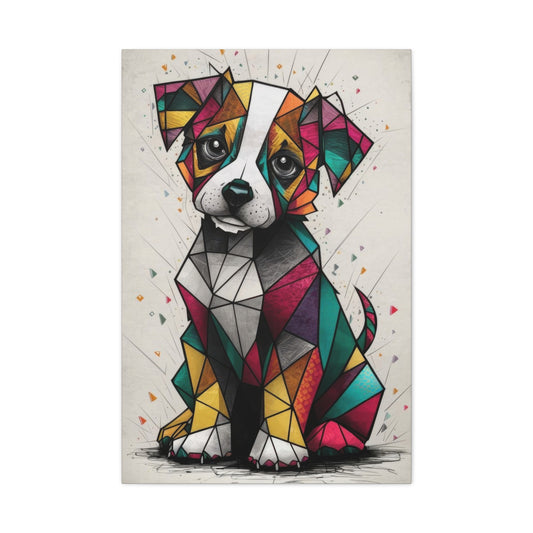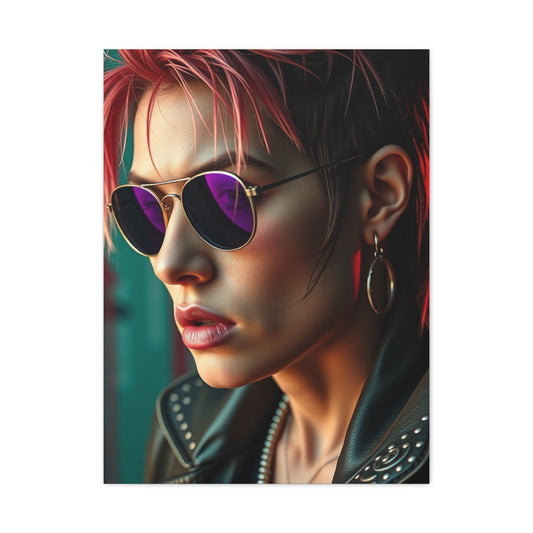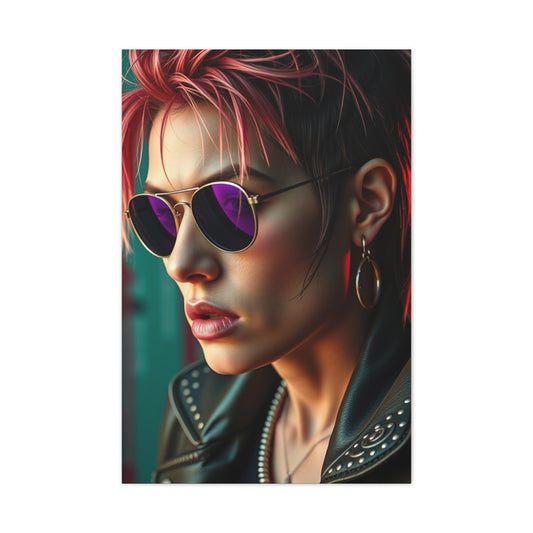When designing a room for children, the goal is to create a space that nurtures their creativity, fosters learning, and offers plenty of fun. A child's room is not just a place for rest and relaxation; it should be a sanctuary for imagination, curiosity, and intellectual development. This guide explores how to integrate interactive, educational, and playful décor elements to transform your child’s room into a space where learning and fun coexist. By choosing the right décor, you can create an environment that encourages growth, exploration, and creativity while also being visually appealing.
Interactive USA Map Wall Art: An Educational Approach to Design
Incorporating educational elements into your child’s room is an excellent way to foster curiosity and learning. One such addition is an interactive multi-panel canvas of the USA map. This vibrant and informative piece of wall art does more than just decorate the room—it serves as an interactive tool that can teach your child about geography, history, and culture in a fun and visually engaging way. Whether you opt for a stylized artistic version or a detailed educational map, the USA map wall art can be a dynamic focal point in your child’s room while promoting learning and exploration.
Benefits of Interactive USA Map Wall Art
An interactive USA map on the wall is more than just a decorative piece. It is an educational tool that encourages curiosity and supports a wide range of developmental skills. The process of studying the map and exploring the locations of different states, capitals, and landmarks helps children build a strong foundation in geography and history. Learning about the United States becomes an engaging and visually stimulating experience, helping children to absorb information in a creative way.
The colors and designs used in USA map wall art also play a significant role in capturing a child’s attention. The bright, bold colors and detailed illustrations offer a captivating visual experience that can make the learning process both enjoyable and effective. The use of vibrant hues can highlight the different states and cities, making it easier for children to recognize their locations and recall information. Additionally, the interactive nature of the map encourages children to actively engage with it, whether they are tracing routes, locating landmarks, or identifying various cultural symbols.
Educational Value of the USA Map Wall Art
One of the greatest benefits of placing a USA map in your child’s room is the opportunity it provides to teach important concepts related to geography, history, and even social studies. Beyond learning the names of states and capitals, a well-designed map can introduce children to other crucial subjects like the physical features of the United States, cultural landmarks, major cities, and regions. It can spark conversations about the unique attributes of each state, such as local traditions, state symbols, and historical events.
The map’s design can also be tailored to include relevant themes, such as national parks, famous monuments, or landmarks like the Grand Canyon or the Statue of Liberty. This approach can make learning even more interesting by connecting the map to real-world knowledge. For example, children can learn about the historical significance of Washington D.C., the cultural importance of California’s Hollywood, or the natural wonders of Yellowstone National Park—all while exploring their USA map wall art.
Incorporating the USA Map into Your Child's Room
When it comes to positioning the USA map wall art in your child’s room, consider placing it in a central and highly visible area. A great place to display the map is above their study desk or along the main wall where the child can easily interact with it. This ensures that the map becomes a regular part of their learning environment.
In addition to being informative, a multi-panel canvas USA map can serve as a stunning focal point in the room. The separation of the map into different panels can create a modern, clean design that complements any room décor, whether you’re going for a playful and colorful theme or a more subtle and minimalist look. The map will effortlessly integrate into the overall design of the room while maintaining its educational value.
A well-chosen map can enhance the aesthetic appeal of the room, making the space feel dynamic and thoughtful. The clean lines and colorful patterns can energize the space, promoting a vibrant learning atmosphere. Whether your child is working on a school project or simply admiring the map, it will act as both a tool for learning and a piece of visual interest.
Maximizing the Educational Impact with Interactive Elements
For added interactivity, consider choosing a map that includes some fun, engaging elements. For instance, some maps feature peel-off stickers, magnets, or other tactile components that allow children to interact with the artwork in a hands-on way. These features can encourage active learning and help reinforce concepts like the location of states or landmarks.
You might also look for maps that include additional features such as a pop-up element that highlights national parks, a colorful key that indicates different regions, or labels that explain important facts about each state. The more interactive the map is, the more engaging it will be for your child, helping them learn while having fun.
Another great way to enhance the educational value of the map is by integrating it with other learning materials. For instance, you can use the USA map wall art in conjunction with books, flashcards, or online resources to deepen your child’s understanding of geography. Regular discussions about the map, as well as activities that revolve around the states and capitals, can help reinforce the knowledge they acquire and make learning more comprehensive.
A Multi-Panel Design for Added Visual Appeal
A multi-panel USA map wall art offers more than just educational benefits—it also provides a modern, stylish aesthetic that can elevate the entire room. The split canvas design gives the room a contemporary look while maintaining the charm and functionality of a traditional map. The panels can be arranged in various configurations, either side by side or stacked, to fit the dimensions and layout of the room.
With the multi-panel design, you can create a more dynamic focal point that stretches across the room, allowing the artwork to draw the eye in and make a statement. This design offers a modern touch while still paying homage to the traditional symbolism of the map. Depending on the space, you could even customize the number of panels to match your room size, creating a tailored look that fits perfectly within the room’s design.
The flexibility of multi-panel art also allows you to move or rearrange the panels over time, giving you the ability to change up the design and adapt it to evolving tastes or needs. Whether you place the panels in a straight line, create a more abstract arrangement, or use them as standalone pieces, a multi-panel canvas USA map provides versatility while maintaining the educational focus.
Adding Personal Flair to Your Child’s Room with USA Map Wall Art
Finally, one of the best aspects of incorporating a USA map wall art in your child’s room is the opportunity to make the artwork uniquely theirs. You can personalize the map by marking special places, such as the child’s birthplace, favorite vacation spots, or locations they’ve yet to visit. This adds an emotional connection to the map, making it a part of their personal journey as they learn more about the world.
The map also offers opportunities for family bonding and interaction. You could make learning about geography a family activity by regularly discussing the map, planning trips, or even hosting “state trivia” nights to test each other’s knowledge of the USA. By integrating this piece of art into your family’s life, it becomes a tool that supports learning while fostering positive memories and experiences.
A Perfect Balance of Aesthetics and Education
Incorporating a multi-panel USA map wall art into your child’s room is an effective and enjoyable way to promote learning while enhancing the visual appeal of the space. With its vibrant colors, interactive elements, and educational value, the map serves as both a stunning decorative piece and a tool for helping your child learn about geography, history, and culture. By positioning the map in a visible and accessible area, you can create a dynamic learning environment that supports your child’s intellectual growth. With endless customization options, the USA map can evolve as your child learns more, making it an investment in both education and aesthetics that will last for years to come.
DIY Art Wall: A Canvas for Creative Expression
Every child thrives on creativity, and there’s no better way to foster their imagination than by giving them a designated space to express themselves. A DIY art wall is not only a space for drawing but an entire creative playground that can evolve with your child’s growth. By setting up an interactive and fun art wall, you’re offering a unique opportunity for your child to explore their creativity while also learning and developing new skills.
Creating a DIY art wall starts with choosing the right surface. One of the simplest and most popular options is to install chalkboard contact paper. This versatile material transforms any section of the room into a canvas for your child to express their ideas freely. Whether they’re doodling, practicing letters, or drawing their favorite cartoon characters, a chalkboard wall makes it easy to start fresh whenever the mood strikes. And the best part? Once your child is done creating, they can simply wipe the wall clean and begin again. This fluidity encourages continuous learning and playful experimentation.
The chalkboard wall provides an excellent space for practicing skills like shapes, letters, and numbers, helping your child engage with both their artistic and academic development. As they grow, this wall can serve as a foundation for more complex art techniques, giving them the freedom to explore different styles and methods. Whether it’s sketching their first picture or developing their drawing abilities, this dedicated space will become a reflection of their creative journey.
For added versatility, consider incorporating magnetic paint into the DIY art wall. Magnetic surfaces are a fantastic way to create an interactive art gallery within the room. You can use magnets to display their latest artwork, photos, or even school projects. This not only allows your child to show off their creations but also fosters a sense of pride and ownership over their space. The art wall evolves as their artistic abilities grow, giving them the power to curate and showcase their works.
A DIY art wall doesn’t just have to be a blank canvas. You can add a variety of materials to inspire further creativity. For example, incorporate frames around the chalkboard to make the artwork feel like a gallery. These frames can house their special creations or display other materials like fabric, paper, or even digital prints they’ve created using a tablet or computer. Mix in some three-dimensional elements like yarn, stickers, or textured paper to encourage them to experiment with different mediums. These additions provide a tactile experience that’s both fun and educational.
A DIY art wall is also a wonderful tool for parents to bond with their children. You can work together on artistic projects, encouraging their exploration of color, texture, and shapes. This collaborative environment fosters not only artistic expression but also strengthens family bonds. For younger children, you can introduce handprints, stamps, or other fun techniques that create lasting memories while they explore their creative side.
Furthermore, an art wall can be an effective tool for enhancing the room's overall aesthetic. Consider using the color scheme and style of the room as a backdrop for the wall. Whether you choose a vibrant pop of color or a calming neutral palette, the DIY art wall can be seamlessly integrated into your child’s room design. In this way, the art wall not only serves as a tool for creativity but also contributes to the room's visual appeal.
This project is both educational and fun. Children learn about shapes, symmetry, and patterns while they enjoy expressing their emotions and ideas through art. A DIY art wall also offers them a space where they can take risks, make mistakes, and learn from them, providing a safe space for self-expression and growth.
In addition to the creative benefits, a DIY art wall serves as an evolving story of your child’s growth. Each artwork they create adds a new layer to their development, allowing them to look back and reflect on how their creativity has evolved over time. For parents, this creates a beautiful record of your child’s progress, providing an emotional keepsake that will last for years.
Creating a DIY art wall in your child's room is a powerful way to nurture their creativity, boost their confidence, and provide a fun learning experience. The possibilities are endless with this hands-on project. It’s a wonderful way to make learning interactive and enjoyable, and it encourages your child to think creatively and develop a love for art that will serve them well for years to come.
Maximizing Creativity with a DIY Art Wall: Final Thoughts
When setting up your child’s DIY art wall, be sure to encourage them to take ownership of the space. As they grow, they can explore new ideas, add elements of their personality, and even change the look of the wall to reflect their evolving interests. This interactive feature of their room will foster their artistic abilities, help them learn new skills, and enhance their emotional development by giving them a space to express themselves freely.
Not only does the DIY art wall serve as a canvas for their artistic skills, but it also offers opportunities for family interaction and bonding. Together, you and your child can celebrate their accomplishments, engage in creative activities, and build a deeper connection through art. Whether it’s displaying their work, collaborating on projects, or simply appreciating their creativity, a DIY art wall is an investment in their growth, learning, and development.
Puzzle Rug: A Practical and Educational Piece
Children are naturally curious and eager to explore the world around them. One of the best ways to foster their curiosity while simultaneously aiding their development is through play that is both fun and educational. A puzzle rug is an excellent addition to any child’s room because it combines both entertainment and learning in one interactive and visually stimulating piece. These rugs consist of interlocking tiles that can be arranged in various configurations, providing endless possibilities for play. The vibrant colors and patterns of puzzle rugs will undoubtedly captivate your child’s attention while also serving as a fun and practical play surface.
The educational value of a puzzle rug is immense. Each piece is essentially a miniature puzzle, allowing the child to manipulate the individual tiles and fit them together to create a cohesive design. This act of arranging the rug’s tiles promotes spatial awareness, helping children visualize how each piece fits into a larger whole. They learn to focus on details while simultaneously developing a broader sense of the complete pattern or shape. The ability to engage with shapes, colors, and patterns in this way stimulates their cognitive development and supports early learning.
As children explore the rug’s colors and designs, they gain a deeper understanding of colors, shapes, and even basic math concepts like symmetry, sequencing, and problem-solving. This interaction with the puzzle rug helps develop fine motor skills, as children use their hands to place the tiles, learning to refine their hand-eye coordination and dexterity. These skills are not only essential for playing but also for everyday tasks, like writing and drawing.
Puzzle rugs offer endless opportunities for creative expression and critical thinking. The colorful tiles can be rearranged, allowing your child to create new patterns and shapes each time they play. This ability to customize the rug provides a dynamic learning experience, as the child is encouraged to experiment with different designs and configurations. This creative freedom encourages independent thinking and problem-solving, which are invaluable skills for young minds.
Beyond the cognitive and developmental benefits, puzzle rugs are also practical. They provide a soft and comfortable surface for your child to play, jump, and tumble on. The rug helps to create a safe and inviting environment, where the child can freely engage with their surroundings. Additionally, the interlocking tiles make it easy to clean and maintain. If one section of the rug gets dirty or stained, you can simply remove and clean that piece without the hassle of washing the entire rug.
Puzzle rugs are available in a wide range of colors, shapes, and themes, making them a versatile addition to any room. Whether your child loves animals, cars, or abstract designs, you can find a rug that fits their interests and personality. For example, a puzzle rug featuring animal shapes can serve as an introduction to the animal kingdom, teaching your child about different species while they play. Similarly, a puzzle rug with bright colors and geometric patterns can help your child understand basic shapes and color combinations.
One of the unique features of a puzzle rug is its ability to grow with your child. As your child’s cognitive and motor skills improve, the rug can evolve with them. What begins as a simple play surface to explore colors and shapes can later become a more complex tool for learning patterns, numbers, or letters. This adaptability makes puzzle rugs a lasting investment in your child’s developmental journey. As they grow older, the rug can continue to serve as a fun and engaging activity, promoting learning through play in ways that are appropriate for their age and abilities.
Furthermore, puzzle rugs can play an important role in the development of social skills. When children play together with the rug, they learn to cooperate and communicate as they work together to solve puzzles or create designs. This type of collaborative play encourages sharing and teamwork, which are essential life skills.
For parents who want to design a functional yet fun space, puzzle rugs offer a wonderful solution. They not only provide a playful and engaging environment for children but also help develop cognitive, motor, and social skills. Puzzle rugs also help encourage learning through play, which is an important part of early childhood development. Whether your child is learning colors, shapes, or numbers, or simply enjoying the freedom to create, puzzle rugs are an interactive and educational addition to any child’s room.
In conclusion, puzzle rugs are far more than just decorative items. They are interactive learning tools that foster creativity, problem-solving, and intellectual development in children. The bright colors and engaging designs will instantly become a focal point in the room, while the opportunity for creative play encourages your child to think critically and independently. With their versatility and educational value, puzzle rugs are a perfect addition to any child’s room, helping them learn, grow, and explore in a fun and safe environment.
Wall Art That Tells a Story: Encourage Imagination Through Art
Storytelling is one of the most powerful tools for developing a child’s imagination, emotional intelligence, and cognitive skills. The beauty of wall art that tells a story lies not only in its ability to brighten up a room but also in how it encourages children to engage actively with the artwork. When children look at wall art that depicts a narrative, they are not just admiring the colors and shapes—they are diving into a world of imagination, enhancing their understanding of characters, plots, and sequences. Wall art that tells a story offers a unique way to nurture creativity, comprehension, and an appreciation for storytelling.
One of the most effective ways to introduce this concept into your child's room is through multi-panel canvas art. Multi-panel artwork often consists of multiple pieces that combine to create a larger image or a sequence, which is perfect for storytelling. For example, a three- or five-panel canvas depicting scenes from classic fairy tales like Alice in Wonderland or The Three Little Pigs can make an enchanting addition to the room. Each panel serves as a chapter, unfolding a part of the story. The beauty of multi-panel artwork is that it gives children the opportunity to follow a sequence, helping them to understand narrative structure, develop logical thinking, and engage with the content in a meaningful way.
As they explore each panel, children can imagine the details of the story, discuss the emotions of the characters, and even come up with their own interpretations of what happens between the scenes. This type of art provides a chance for children to use their imagination to complete the story, fostering creativity and critical thinking. Over time, they may start to visualize other stories or create their own narratives, inspired by the art they see. This will enhance their understanding of literature and storytelling, allowing them to learn in a fun and immersive way.
Moreover, storytelling wall art can be used to help children grasp important life lessons. For example, wall art depicting The Tortoise and the Hare or The Boy Who Cried Wolf can teach children valuable lessons about patience, honesty, and the consequences of their actions. Storytelling art is not just for entertainment—it can also serve as a tool for imparting moral lessons in a subtle and visually appealing way. With the right themes, these pieces can spark important discussions, allowing children to reflect on the messages within the stories.
For a more contemporary twist, you can opt for wall art inspired by modern children's literature or original pieces that tell new stories. Abstract art that suggests a story or evokes emotions, rather than portraying a literal narrative, can also be effective in stimulating a child’s imagination. For instance, an abstract painting with swirling patterns and vibrant colors may encourage children to come up with their own stories based on what they see. This invites them to use their creativity to interpret the art, blending art and storytelling in a unique way.
In addition to classic stories, nature-themed wall art is a wonderful way to combine education with creativity. Illustrations of animals, plants, and landscapes not only beautify a room but also introduce children to the natural world. Imagine a multi-panel art piece depicting a forest scene where each panel shows different animals or elements of nature. This allows children to imagine the interconnectedness of life in the natural world while teaching them about different species and ecosystems.
Nature-based wall art can also be interactive. For instance, a wall art piece that features a tree with branches that children can ‘decorate’ with colorful leaves or flowers provides a hands-on experience. Children can participate in creating the artwork, enhancing their sense of involvement and engagement with the story. This is particularly effective for younger children, as it helps to build their fine motor skills while making learning fun.
Another interesting way to engage children with storytelling through wall art is by incorporating educational themes. You could use wall art that explores historical figures, places, or events, turning a child's room into an interactive history lesson. A series of canvases that explore famous explorers or inventions can inspire curiosity and a deeper understanding of history. This approach offers a mix of education and aesthetic beauty, sparking interest and conversation about the world beyond their immediate surroundings.
In addition to purely visual art, you can also integrate storytelling through wall art that incorporates other sensory elements. Consider art pieces with textures or elements that children can touch. For example, a wall mural with fabric or 3D components can make the experience of storytelling more tactile and immersive. These multi-sensory experiences are particularly helpful for younger children, as they stimulate their senses and encourage a deeper engagement with the art.
To further personalize the experience, you could involve your children in creating the art for their room. Allow them to paint or draw their own stories, which can then be framed and displayed on their walls. This not only makes the art more personal but also helps children take ownership of their space. It’s an empowering experience that builds confidence and creativity.
Stickers and Decals for Easy Learning
Stickers and decals are incredibly versatile tools that can bring both fun and education into your child’s room. Whether you’re looking for an interactive way to encourage learning or simply want to make the room more vibrant and engaging, these simple decorative items can do it all. From teaching basic skills like organization and categorization to fostering creativity, stickers and decals can serve as an educational tool while enhancing the aesthetic appeal of your child’s space. Let's explore how you can use these innovative and colorful decorations to transform your child’s room into a fun and dynamic learning environment.
Educational Stickers for Organization and Categorization
One of the easiest ways to introduce learning into your child’s room is through educational stickers. These small but mighty tools can be used to label everyday items and help children develop organizational skills in a playful way. By labeling their toy chest, drawers, or bookshelves with colorful stickers, you not only enhance the room’s décor but also help your child connect words with objects. For instance, you could place a sticker that says “animals” on a toy chest filled with animal toys, or “cars” for their collection of miniature vehicles. This allows children to associate everyday objects with written words, improving their vocabulary and cognitive skills.
As children grow, the types of labels can evolve as well. Initially, you might start with simple objects like “shoes,” “books,” or “toys,” but as their knowledge and understanding expand, you can add more advanced labels such as “colors,” “shapes,” or even “emotions” to reinforce new learning concepts. This method of incorporating stickers into the organization process helps children better understand categorization, which is an important cognitive skill.
Interactive and Fun Decals to Enhance Learning
While stickers are excellent for organizing and labeling, decals offer another fun way to enhance the learning experience. Decals are larger and more elaborate than stickers, making them ideal for creating thematic learning spaces. You can transform your child’s room into a mini nature reserve, a zoo, or even a colorful classroom with educational decals that feature numbers, letters, animals, or shapes.
For instance, you can decorate the walls with a nature-themed mural using decals of wild animals like lions, elephants, tigers, and birds. This approach introduces your child to the animal kingdom in an engaging and visual manner. By associating these lifelike images with the names of the animals, your child can begin to recognize both the animals and the words associated with them. You can make it more interactive by adding educational facts about each animal, such as their habitats, diets, or behaviors.
Decals are also an excellent way to teach children basic concepts such as the alphabet and numbers. You can place large, colorful letter decals on the walls or above their study desk to reinforce learning as they play or study. Using a combination of numbers, letters, and animal decals allows children to associate different learning concepts with fun, visual elements that make the process feel like play rather than work.
Adhesive Decals for a Nature-Inspired Environment
One of the key benefits of using decals is that they can create an immersive environment for your child. Nature-inspired decals, such as trees, flowers, clouds, and animals, can help bring the outdoors inside. For a truly educational and visually rich experience, consider using a photorealistic wall mural or a set of lifelike nature decals that show animals in their natural habitats, such as jungle scenes with monkeys, elephants, and tropical birds, or ocean themes with sea creatures like dolphins and whales.
This type of nature-themed décor is not only aesthetically pleasing but also helps teach your child about the environment. They can learn about various ecosystems, the animal kingdom, and environmental conservation through the imagery that surrounds them. As they grow older, these decals can serve as a conversation starter, allowing you to discuss wildlife, conservation efforts, and the importance of protecting nature with them.
Benefits of Stickers and Decals for Child Development
The use of stickers and decals in the room goes beyond just decoration; it also plays a crucial role in child development. By incorporating educational elements into the décor, you’re providing your child with constant exposure to learning materials. For younger children, stickers with shapes, numbers, or letters help familiarize them with fundamental concepts that will serve as the building blocks for later learning. Meanwhile, for older children, decals featuring facts about animals, geography, or even the solar system can enhance their knowledge base in an interactive way.
Stickers and decals also help build fine motor skills as children peel, place, and arrange these items on the wall or furniture. This hands-on activity strengthens their hand-eye coordination and dexterity, all while having fun. As a bonus, many decals are removable, which allows children to rearrange or redecorate their spaces as they see fit, promoting independence and creativity.
Using Stickers and Decals for Emotional and Social Learning
In addition to academic learning, stickers and decals can also contribute to emotional and social development. Consider adding motivational quotes or affirmations to your child’s room, which can help build their self-esteem and confidence. Phrases like “You are loved,” “Be kind,” or “Dream big” serve as positive reinforcement that fosters a sense of self-worth and emotional well-being.
Interactive and affirming stickers can also teach children important life lessons. For instance, stickers that depict kindness, teamwork, or respect can encourage positive social interactions and help your child understand the importance of good behavior and empathy. These types of decals can be especially valuable for reinforcing the values you want to instill in your child as they grow and develop.
Customizable Stickers and Decals for Personalization
One of the most appealing aspects of using stickers and decals in your child's room is the ability to personalize their space. Children love to express themselves, and customizable stickers give them the freedom to add their own unique touch to their room. Allowing your child to pick out their favorite colors, characters, or themes for their room’s décor can help them feel a sense of ownership and pride over their space.
From superhero decals to fairy tale characters or favorite animals, the possibilities are endless. Customizing the space based on their interests not only makes their room more personalized but also helps them develop a stronger connection to their environment.
Creating a Learning-Centered Space with Stickers and Decals
Stickers and decals are a simple yet effective way to bring education, fun, and creativity into your child’s room. Whether you’re organizing their toys, introducing them to new concepts, or decorating with nature-inspired motifs, stickers and decals provide an interactive and visually engaging way to enhance their learning environment. By making learning fun and accessible through colorful, educational, and personalized designs, you can turn your child’s room into a space that encourages growth, creativity, and development.
Explore the endless possibilities for incorporating educational wall art, stickers, and decals into your child’s room and watch as they learn and thrive in a space that reflects their unique personality and creativity.
Mirrors: Teaching Self-Recognition and Self-Love
Mirrors are an essential part of childhood development, as they help with self-recognition. When children first see themselves in the mirror, it can be a moment of self-discovery. A mirror placed at the right height allows them to practice facial recognition, which is an important step in cognitive development.
To enhance the educational aspect, consider using mirrors that incorporate fun designs. For example, you can have mirrors shaped like animals, stars, or hearts to make this learning process enjoyable. As your child engages with their reflection, they’ll also learn about their identity and self-awareness in a non-threatening way.
Bulletin Boards: Showcasing Creativity and Achievements
Bulletin boards are a great way to display your child’s artwork, projects, or achievements. This space allows children to feel proud of their creations and to see the value in their work. By regularly updating the bulletin board, children learn about the importance of organization and take ownership of their space.
This display area can also include educational materials, like flashcards, inspirational quotes, or even small reminders about daily activities. Organizing this space not only encourages creativity but also provides an area for your child to showcase their hard work.
Nature-Inspired Décor: Connecting with the Earth
Introducing natural elements into your child’s room can provide a calming, grounding effect. Along with houseplants like succulents and ferns, consider incorporating wood, wicker, or stone into the room’s décor. Natural materials add warmth and texture to the space, creating a peaceful, relaxing environment for your child to unwind after a day of learning and play.
You can complement this nature theme with animal-themed wall art, such as illustrations or sculptures of wildlife. These nature-based educational décor pieces encourage children to learn about the environment, fostering a sense of appreciation for the natural world.
Conclusion:
Creating a space that’s both fun and educational for your child doesn’t have to be difficult or expensive. With interactive elements like DIY art walls, educational wall art, and creative accessories such as puzzle rugs and mirrors, you can design a room that stimulates your child’s intellectual and emotional growth. Nature-inspired elements and educational tools further enrich their learning experience.
By adding these creative décor ideas to your child’s room, you’re setting the stage for a dynamic, exciting, and nurturing environment. What are you waiting for? Begin the transformation of your child’s room and create a space that sparks creativity, fosters growth, and encourages a love for learning. Whether through art, décor, or interactive design, there are endless possibilities to create an inspiring room for your child to learn, play, and grow.










